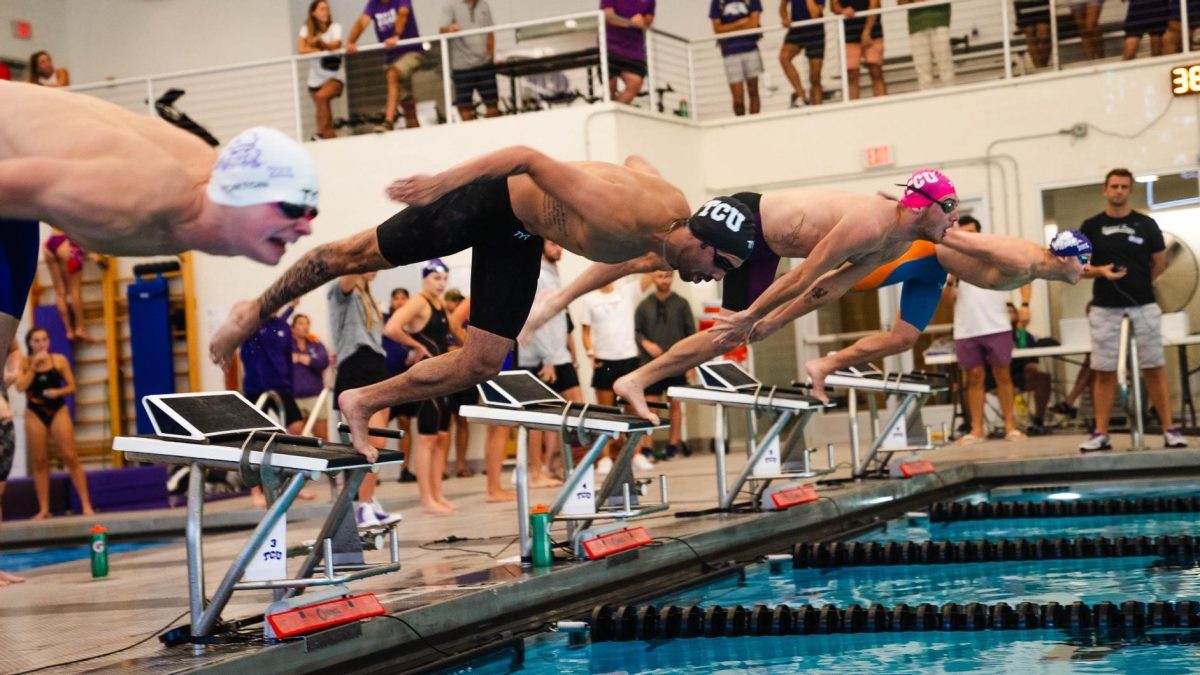Standing between one to 10 meters above water, divers must put all their focus on a single jump, a single dive and, hopefully, a single execution.
Once in the air, divers are judged subjectively. Judges assess divers based on their form, how straight their legs are, how pointed their toes are and the degree of difficulty of the dive. They use a rating system of one to 10 with a 10 being a perfect score.
Senior TCU diver Curtis Muller said there are six things that go through a diver’s mind while on the platform: “Calm down, close your eyes, slow your heart rate, imagine the dive, take a deep breath and go.”
Muller said he thinks about beauty and grace while in the air.
“As weird as it sounds, try to be as pretty as you can and try to have that one fluid motion,” he said.
Junior TCU diver Kristen Connolly said diving requires self-confidence. Despite all the technicalities required by each dive, Connolly said she focuses on slowing her heart rate down enough so that she can actually take the jump.
“There is nothing better than getting a good ride out of the board, doing your dive, and entering the water like you know you have done well,” Connolly said.
Muller and Connolly have been members of the TCU Swimming and Diving team since their freshmen year under the direction of diving coach Wayne Chester.
“Divers have to be mentally tough, diving is almost 95 percent mental,” Chester said.
Connolly has competed in the Big 12 Championships in the 1-meter, 3-meter and platform events. In 2014, she was a participant in the NCAA Zone Diving Championships. This past season, Connolly placed first in the 3-meter dive with a score of 258.15 against the University of North Texas.
In 2014, Muller placed fourth at the Big 12 Championships with a score of 260.35.
“They need to dive smart.” Chester said. “[They] think about what they are doing and not just go through the motions. They think about making a 10 on the dive and I don’t want them to do that. I want them to think about the individual components.”
Connolly and Muller both said they have their own favorite dives. Connolly said her favorite dive is a front one half with a double twist.
“I learned it my freshman year of college and it is fun because I can do it well, but it took me so long to get it,” she said.
Muller said his favorite is a front three and a half tuck.
“I focus on the very end of the board, take a deep breath and I just know I can do it really well. I go really slow to extremely fast in a short period of time,” he said.
To spectators, a dive is finished in a matter of seconds. It is a quick jump and then a splash in the water.
Connolly said time goes by slower when she is diving.
“It is such a quick motion, but in that moment you are completely aware of what just happened,” she said.
Connolly also said it takes a lot for a person to make that jump, and that they must have the ability to overcome their fears.
Muller said some things divers fear include: smacking the water, or hitting their hands, feet or head on the board. But for some, it is the fear of not executing the dive.
“Sure, I have some scars and bruises on my feet from diving,” Muller said. “They are staying with me, but I did it. As long as you train your brain not to be scared, you can do the dive.”
Chester said you have to enjoy diving to dive.
“There is a natural ability you have to have,” he said. “As far as gymnastics background, no, but they have to enjoy it.”



